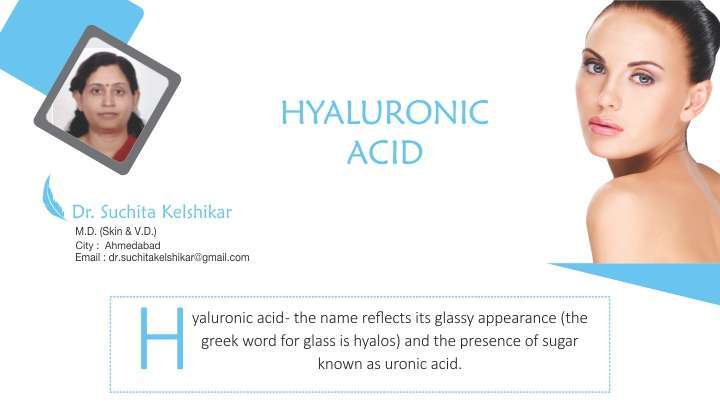Hyaluronic acid – the name reflects its glassy appearance (the greek word for glass is hyalos) and the presence of sugar known as uronic acid.
Introduction
H.A. also called hyaluronan is anionic, nonsulfated glycosaminoglycan distributed widely throughout connecting, epithilian and neural
tissues. The average 70kg person has roughly 15gms of H.A. in the body, one-third of which is turned over (degraded and synthesized) every day. H.A. is an important component of articular cartilage, as a coat around each cell (chondrocyte). H. A. with other molecules form an aggregate which imbibes water and is responsible for the resilience of Cartilage. A lubricating role of H.A. in muscular connective tissues to enhance the sliding between adjacent tissue layers has been suggested. H.A. has many benefits and is one of the most interesting ingredients In skin care specifically. Naturally found in the body, H.A. appears freely in the dermis. H. A. is found at the periphery of the collagen and elastin fibers and at the interface of this type of fibers. H.A. appears to also play a role in keratinocyte differentiation and formation of lameller bodies via its interaction with cd44, a cell surface glycoprotein receptor with h.a. binding sites. H.A. secures moisture and creates fullness-youthful skin naturally abounds with H.A. In skin care, you can find H.A. creams, serums, injectables and H.A. supplements
Benefits of H.A. In Skin
As we age, skin moisture can drop significantly, which makes the skin
lose elasticity and expose the signs of aging on the skin. H.A. plays a critical role in skin health with its unique ability to hold moisture (1000 Ml of water per gram of H.A.) and hence it is excellent at plumping up and hydrating skin cells. Collagen the most abundant protein in the body is critical to the skin because it supports skin structure as a body.
Collagen declines the appearances of wrinkles and discoloration becomes more visible. maximizing collagen levels will keep skin supple. Primary cause of degeneration of the collagen network of skin is decreased levels of hydrated hyaluronic acid which supports the collagen network. Restoring H.A. plumps the skin cells and restores the moisture in all the tissues of the body. Thus H.A. contributes to the anti ageing benefits to the skin.
one of the most skin damaging elements are the UVB rays from the sun. h.a. benefits the skin as it protects the skin from UVB rays. (And Scavenging reactive oxygen species they generate), which can cause sun spots. H.A. Is also a “smart nutrient” as it can adjust its moisture absorption rate based on humidity-relative to the season and climate. Researchers have found H.A. supplementation to be directly correlated to measured increases in skin moisture. Microscopic skin surface analysis show increased skin smoothness, and amelioration of wrinkles, a lack of H.A. in body joints can set in process of the progressive wear and tear leading to cartilage destruction, joint pain reduced a flexibility and osteo arthritis. H.A. can help with healing because it provides cushioning between the joints that then enables cartilage to restabilize. Levels of H.A. have been found to be lower than normal in people suffering from dry eyes syndrome and there is justification in the use of this supplements for this concern as well as helping to alleviate vaginal dryness.
How to retain H.A. in the Body
U.V. radiation from the sun can cause skin cells to reduce their production of H.A. One can use specific foods and supplements to Increase the amount of H.A. in the body.
The foods high in H.A. are potatoes and other root vegetables such as carrots, and sweet potatoes, green leafy vegetables such as kale and spinach. Asian vegetables such as imoji, koanyaku and satoimo also have high concentration of H.A.
H.A. is sensitive to heat and will be destroyed by cooking so it is better to eat the vegetables raw. H.A. is more effective when it has an abundant amount of water with which to bind hence it is recommended to drink plenty of water.
Oral supplements of H.A. can be taken. The F.D.A. has not established a minimum daily requirement for H.A. but a common recommended dosage is 200mg twice a day. Topical preparations can be used of H.A. to make the skin smoother And suppler.
H.A. Derma Fillers
H.A. fillers acts like an inflated cushion to support facial structures and tissues that may have lost its volume or elasticity due to normal ageing. It also brings water to the surface of the skin to keep it looking soft and supple. In the last few decades, various synthetic forms of H.A. have been developed and used to correct disorders in the fields of rhuematology, ophthalmology and wound repair. More recently, synthetic forms of H.A. are being manufactured for use in face augmentation. Hence h.a. is aptly called the’ fountain of youth.’






